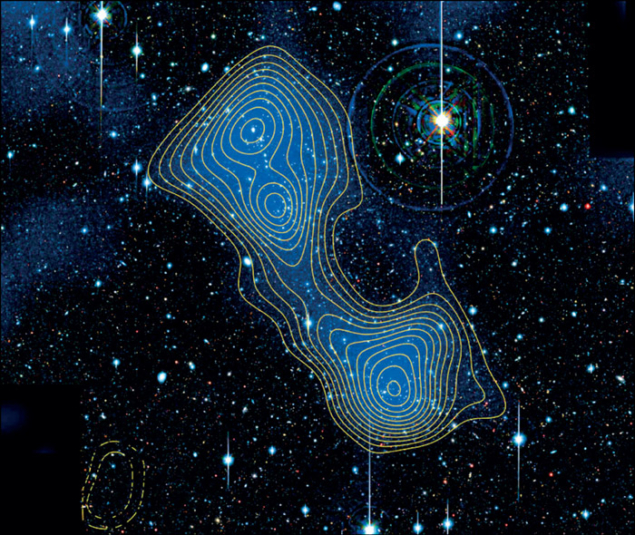
Image credit: J P Dietrich et al. 2012.
Numerical simulations of structure formation in the universe reveal how clusters of galaxies form at the intersection of dark-matter filaments. The presence of such a filament connecting the galaxy clusters Abell 222 and Abell 223 has finally been detected through its weak gravitational lensing effect on background galaxies.
With the advent of supercomputers it became possible to simulate the action of gravity over cosmic time starting from a rather uniform distribution of matter in the early universe (CERN Courier September 2007 p11). Time-lapse films based on these simulations show the evolution of structure formation in a large volume of the universe. While the universe expands globally, gravity tends to collapse small initial regions of over-density. Matter is therefore contracting locally while being stretched on large scales. The opposite effects of gravitational collapse and cosmic expansion result in a sponge-like structure with a web of filaments delimiting big voids. The densest regions are at the intersection of filaments and are the formation sites of clusters of galaxies. As time proceeds, matter flows along the filaments to the nearest cluster, making the filaments thinner and thinner.
This sponge-like distribution of matter in the universe has been confirmed by mapping the position of thousands of galaxies in the nearby universe for decades. According to the simulations, it is primarily cold dark matter that collapses to shape the filamentary skeleton of the universe; normal, baryonic matter follows the same route to form galaxies along these filaments. The detection of warm–hot intergalactic gas along walls of galaxy over-densities was another piece of evidence for the validity of this scenario (CERN Courier July/August 2010 p14). What remained to be detected was the actual presence of dark matter in these filaments. This has now been achieved by Jörg P Dietrich of the University of Michigan and collaborators in Germany, the UK and the US, looking at the galaxy supercluster Abell 222 and Abell 223.
The technique used to map the distribution of dark matter in clusters of galaxies is always the same. It is called weak gravitational lensing and consists of measuring the small distortion of the shape of background galaxies induced by the presence of the invisible matter (CERN Courier January/February 2007 p11). As mass distorts space–time locally, it changes the path of light from remote galaxies and thus alters their shape as observed from Earth. The problem is that the true shape of the individual galaxies is not known, so it is difficult to know how strong their distortion is. However, by analysing tens of thousands of galaxies, a global trend of distortion can emerge with statistical significance.
Dietrich and colleagues find a bridge of matter between Abell 222 and Abell 223 at the 96% confidence level. The derived surface density of this structure is unexpectedly high compared with dark-matter filaments in numerical simulations. This suggests that the filament is not seen from the side but almost along its major axis, thus increasing its projected mass. The red-shift difference between the two galaxy clusters does, indeed, suggest that they are at about 60 million light-years apart. The binding filament contributes as much as a complete galaxy cluster to the total mass of the supercluster. It is the site of an over-density of galaxies and includes hot intergalactic gas detected in X-rays. This gas contributes to about 9% of the total mass of the filament at most. The remaining mass would essentially be composed of dark matter. This discovery is new evidence that the basic assumptions of numerical simulations are valid; in particular, that cold dark matter is an essential ingredient governing the formation of large-scale structures in the universe.








